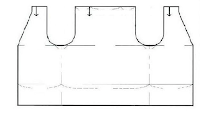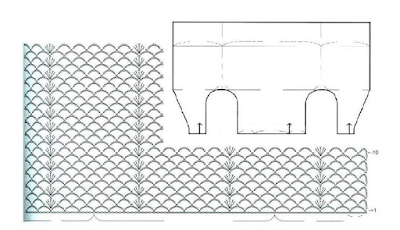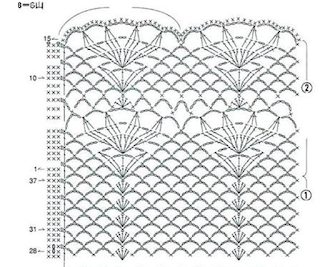FRONT OPEN SHELLED VEST
When I saw this pattern on some Pinterest board,
I just loved it.. and it’s this simple pattern with this really lovely shelled
pattern at the end – I mean, how can anyone resist this, right?
Obviously you can’t either, as you’re back here
with me.
Thank you for joining me.
In case you have just joined me, know that you can access all of my earlier creations by checking under ‘categories’ on the right hand side of this blog under “Labels”. Then, for your convenience, follow me here or on Facebook, You Tube, Pinterest, Twitter or Instagram.
Check out all my social media handles at the bottom of this blog
Oh, and may I add that the fastest way to find any of my blogs is via Pinterest.
All my blogs can be printed. Find the printer friendly (green) link on the right side of this blog. You can also hit Control P (or Command P for Mac) on your keyboard, and the blog will go directly to the connected printer.
Remember that you only print if absolutely essential. Save paper – Save Our Earth.
Do remember to add my blog URL when you make and show off your creation.
Just copy the link on the search bar above - that's the blog URL.
To purchase this or similar yarn online, click here to buy your yarns online via Amazon. While you will still pay the same, I may get paid by Amazon as well.
This is a free blog - so do pay it forward for me. Cheers.
This is not my original pattern. I found this
photograph and a convenient chart on the internet.
As I work on this pattern, I’ve written down my
notes that I share with you.
As I reached the border, I realized
that I’ve started my vest from the bottom up, but the chart is from the
shoulders down. Ah well, this is how
I’ve done it.. and there’s a chart attached.. so go ahead and work it whichever
way suits you.
Materials used : Today
I’ve used our superb Indian Anchor knitting cotton yarn, with a 3 mm crochet hook General yarn info : The yarn used today is not specific to this pattern.
You can use any yarn with a suitable hook to make this project to any size.
International yarns : Among the international yarns I have used, I’d suggest Aunt Lydia Cotton 10, Aunt Lydia Bamboo-Viscose 10, DMC Petra, Sullivans knitting cotton (Australia), Milford Soft, Hilaza Rustica Eclat , Alize cotton yarn and Alize bamboo yarn.
Skill level :
Intermediate
Abbreviations used : (Using U.S terminology)
dc
: Double crochet
ch : chain ch-sp
: chain space
sp : space rep
: Repeat
sc : Single crochet
st(s) : Stitch(es) hk : Hook
sl-st : Slip stitch yo : Yarn over
lp(s) : Loop(s)
fsc : Foundation single crochet
Stitches used : (Using U.S terminology)
dc 3-tog : Double
crochet 3-tog : [yo, insert hk in st or ch-sp,
yo and pull up a lp ; yo and draw through 2 lps] 3 times (4 lps on hk) ; yo,
draw through all lps on hk. One dc 3-tog
made.
Instructions : (Using U.S terminology)
Please note that I start all my rows with a ch 1, turning chain for ease.
Please check the top of this blog for easy video tutorials on all stitches used in today's pattern.
Please read through all my notes before you pick up your hook, so you know just where we're heading in our pattern.
In my patterns I work with the principle of stitch count and body measurement. This means that you need to work the stitch count in pattern, till you get the measurement (length and/or width) that you need for your project.
Part 1 :
Quick analysis of what we’re going to do here
today.
With this
stunningly simple pattern, we’re going to work our whole vest in one piece,
starting at the base of the vest, working towards the shoulders.
At the armhole / neck level,
we’ll divide off and work the two fronts and one back part of the vest
separately.
So we’re working in one piece
from waist up – so our start row needs to be the same measure as your Round
Waist or round bust (whichever is the larger measure).
Remember that we are working in one piece, so we're working on the round body measurements.
Start with fsc in multiples of 24+ 1 (Round waist / bust measure)
Single Crochet : Sc : yo, insert hk into st ; yo (2 lps on hk); yo, draw through both lps. One sc made. Check out the video at https://youtu.be/ghACqBpA-3k
First stitch for Single Crochet : This is how I like to start my row of sc. Check out the video at https://youtu.be/6pVYRfsf4_M
Row 1 : sc in the 1st fsc ;
(ch 5, sk next 3 fsc , sc in the next fsc) ;
rep (to) till end.
Turn.
Row 2 : dc in the 1st sc ;
ch 2, sc in the next ch-5 sp
;
(ch 5, sc in the next ch-5 sp)
;
rep (to) once ;
*5 dc in the next sc ; sc in
the next ch-5 sp ;
rep (to) 5 times* ;
rep *to* till last ch-5 sp ;
sc
in that last ch-5 sp ;
ch 2, dc in the last sc.
Turn.
Note : I decided to do 3 dc instead of 5 dc in that sc, but as you
can see, it doesn’t really change the pattern that much.
Double Crochet : dc : yo, insert hk into st ; yo (3 lps on hk);
[yo, draw through 2 lps] twice. One dc made.
Chainless start for Double Crochet : I dislike the ch-2 / ch – 3 start, and this is what I do to start my row of dc.
Row 3 : sc in the 1st dc ;
(ch 5, sc in the next ch-5
sp) ;
rep (to) once ;
*ch 5, sk next 2 dc, sc in the
next dc ;
ch 5, sk next 2 dc, sc in the next ch-5 sp ;
rep (to) 5 times* ;
rep *to* till last end. Turn.
Row 4 : dc in the 1st sc ;
ch 2, sc in the next ch-5 sp
;
(ch 5, sc in the next ch-5 sp)
;
rep (to) once ;
*5 dc in the next sc ; sc in
the next ch-5 sp ;
rep (to) 5 times* ;
rep *to* till last ch-5 sp ;
sc
in that last ch-5 sp ;
ch 2, dc in the last dc.
Turn.
Rep Row 3 & 4 till your
project reaches the armhole / neckline level , ending with Row 3.
In this project,
we’re going to divide for armhole and neckline at the same point.
We will then work one part for the back, and
the two fronts till the shoulder level.
So off we go.. and we’ll meet
shortly for the divided part, just off the armhole.
Once you’re at that point, fold
your project into four – and ensuring that you have two fronts and one back,
mark the points for the armhole. (see chart below)
Now the armhole opening is over
five ch-5 sps.
So where ever your centre / armhole point comes in, ensure you
have two ch-5 sps on either side of that centre ch-5 sp. Got it?
Now for convenience, let’s move
markers to the ‘end points’ of the armholes, such that we now have four markers
(two for each end of the armhole).
This is also the point where
we’ll be reducing for the neckline and making a nice “V”-neck there too.
Part 2 :
For convenience, I’m going to
restart row numbering from 1 again.
Please note that any instruction from here on will refer only to
these row numbers.
Now our pattern is not changing
in any way, and as you’ve done it so many times now, you know it off by
heart.
So the instructions below may be
a bit hazy as we’re probably going to be making decreases at different points.
I am going to write it down in general, and
hope (fingers crossed) that you’ll understand what I mean.
Row 1 : dc in the 1st sc, sc in the 1st ch-5
sp ;
(ch 5, sc in the next ch-5 sp)
;
rep (to) once ;
[5 dc in the next sc, sc in the
next ch-5 sp] ;
*rep (to) and
[to] till one ch-5 sp before marker ;
dc in the marker. Turn.
Row 2 : dc in the 1st dc ; sc in the next ch-5 sp ;
(ch 5, sc in the next ch-5 sp)
;
rep (to) once ;
ch 5, sk next 2 dc, sc in the next dc ;
ch 5, sk next 2 dc, sc
in the next ch-5 sp ;
rep (to) till the last ch-5 sp ;
dc in that last ch-5 sp. Turn.
So these are basically the
decreases we’re working at each end, one each at the armhole and neckline end.
Now depending on how deep you
wish your armhole and how slender a shoulder you wish, decrease the neckline to
get a nice “V” shape.
Once you’ve
achieved the shoulder width, continue with the pattern without further decrease
till your project reaches the shoulder level.
I also suggest that you make a
note of what you’re doing for this side of the front, so you can then duplicate
it for the other side too.
Reduce for the armhole section
around the back till your project reaches the shoulder level, as the back goes
up all the way to the shoulder.
So the question here could be,
where do we decided how far we work this and how much do we leave for the
border..
Well, here’s what I did.. As
we’re working the border from the other side of the fsc start row anyway, I
cheated.. as soon as I finished one ball of yarn, and as we’re working the
front-back in a continuous piece anyway, I just decided to work the full
border.. and then decide where I’d split for the armhole(s).
Cheater? Yes..
Did it work? Yup.. it did
Fasten off leaving a tail for
attachment.
Join the front and back shoulder bits and then we’ll go down
to the border.
Part 3 : Border :
For the border, we will go back
to that foundation fsc row and work from the other side of that row.
We will start our shells from
each of the 5-dc sets that we have.
Border Row 1 : sc in the 1st fsc ;
(ch 5, sk next 3 fsc , sc in the next fsc) ;
rep (to) once ;
[sk next 3 fsc , 2 dc in the
next fsc ;
ch 2, dc in the same fsc ;
ch 2, 2 dc in the same fsc]
;
sk next 3 fsc, sc in the next fsc ;
*rep (to) 4 times ;
rep [to]
once* ;
rep *to* till end. Turn.
Border Row 2 : dc in the 1st sc ; ch 2, sc in the next ch-5 sp
;
(ch 5, sc in the next ch-5 sp)
;
[dc in the next 2 dc ;
ch 2, 6
dc in the next dc ;
ch 2, dc in the next 2 dc] ;
sc in the next ch-5 sp ;
*rep (to) 3 times ;
rep [to]
once* ;
rep *to* till last ch-5 sp ;
sc
in that last ch-5 sp ;
ch 2, dc in the last sc.
Turn.
Border Row 3 : sc in the 1st dc ;
ch 5, sc in the next ch-5 sp
; ch 3, sk next 2 dc,
[2 dc in the next dc] ;
rep
[to] 5 times ;
*ch 3, sc in the next ch-5 sp ;
rep (to) 2 times ;
ch 3, rep [to] 6 times* ;
rep *to* till end. Turn.
Border Row 4 : dc in the 1st sc ;
ch 2, sc in the next ch-5 sp
;
(ch 2, dc in the next 3 dc) ;
rep (to) 3 times ;
*ch 2, sc in the next ch-5 sp ;
ch 5, sc in the next ch-5 sp ;
rep (to) 4 times* ;
rep *to* till end ;
ch 2, dc in
the last sc. Turn.
Border Row 5 : sc in the 1st dc ;
(ch 5, dc 3-tog over the
next 3 dc) ;
rep (to) 3 times ;
ch 5, sc in
the next ch-5 sp ;
*rep (to) 4 times ;
ch 5, sc in
the next ch-5 sp* ;
rep *to* till end.
Once the border is done, rather
than fastening off, I’d suggest you run a round of dc’s all across the front
placket, around the back of the neck and down the other side of the front
placket. I also decided to work one
round of sc’s all across the border (an sc in each ch-st and each dc 3-tog) and
this gives that edge a nice firm finish too.
Fasten off and weave in ends.
Give yourself a big pat on the
back as this one has really been a great project – but totally worth it, I’m
sure you’ll agree.
And that’s done.. yet another
project brilliantly executed !
Enjoyed this ?? I sure did.. Come back right here for more freebie patterns
Remember to share this blog post when you share your photos with me on Facebook. I’d love to feature your photos on my FB page. Cheers.
If you're visiting me here for the first time, and have liked the experience, do add me to your mailing list (for your convenience) , and all my future free patterns will come straight to your mail box.
I’d appreciate if you could credit my blog (and link the original pattern link) when you make your own creation. Thanks.
Have a great day and see you soon.
I have a few tops already
made, and just
in case you want a dekho at those free patterns … here you go
and a doll’s top..
and some bolero/jacket/vests that will look grand on a top..
I have a few girls dresses, and just in case you want a dekho at those free patterns … here you go
For cute hair embellishments and motifs check the links below.
..and some belts..
and here are a few skirt patterns that you can use your belt for..




























No comments:
Post a Comment
Thanks for taking the time to stop by. Do tell me what you think. Cheers